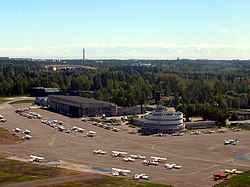| 1938 Helsinki | |
|---|---|
 Malmi airport in 2006, with the round terminal of 1938 | |
| Overview | |
| BIE-class | Specialized exposition |
| Name | Second International Aeronautical Exhibition |
| Building(s) | Malmi Airterminal |
| Area | 15.2 hectares (38 acres) |
| Visitors | 15,000,000 |
| Participant(s) | |
| Countries | 25 |
| Location | |
| Country | Finland |
| City | Helsinki |
| Venue | Helsinki-Malmi Airport |
| Coordinates | 60°15′14″N25°02′39″E / 60.25389°N 25.04417°E |
| Timeline | |
| Opening | 14 May 1938 |
| Closure | 22 May 1938 |
| Specialized expositions | |
| Previous | ILIS 1936 in Stockholm |
| Next | Exposition internationale de l'eau (1939) in Liège |
| Universal Expositions | |
| Previous | Exposition Internationale des Arts et Techniques dans la Vie Moderne in Paris |
| Next | 1939 New York World's Fair in New York City |

The Second International Aeronautic Exhibition, (full name Second International Aeronautical Exhibition in the league Air Defence of Finland SILI) was held in Helsinki in 1938. [1] It ran from 14 May to 22 May 1938.
Contents
It was a special exhibition recognised by the Bureau International des Expositions (BIE) which attracted 25 participating countries including Czechoslovakia, Finland, Germany, Great Britain, Hungary, Latvia, and Sweden; and 15 million visitors and took place in Helsinki's exhibition hall. [2] The commissioners were Alexander Frey, Erik von Frenckell and Mauri Honkajuuri director of Kansallis-Osake-Pankki. [2] Visitors included the racing driver S. P. J. Keinänen and the prime minister Aimo Cajander [3]
Aircraft on display included Morane-Saulnier Type L, Fokker C.X, VL Tuisku and VL Viima. [3]